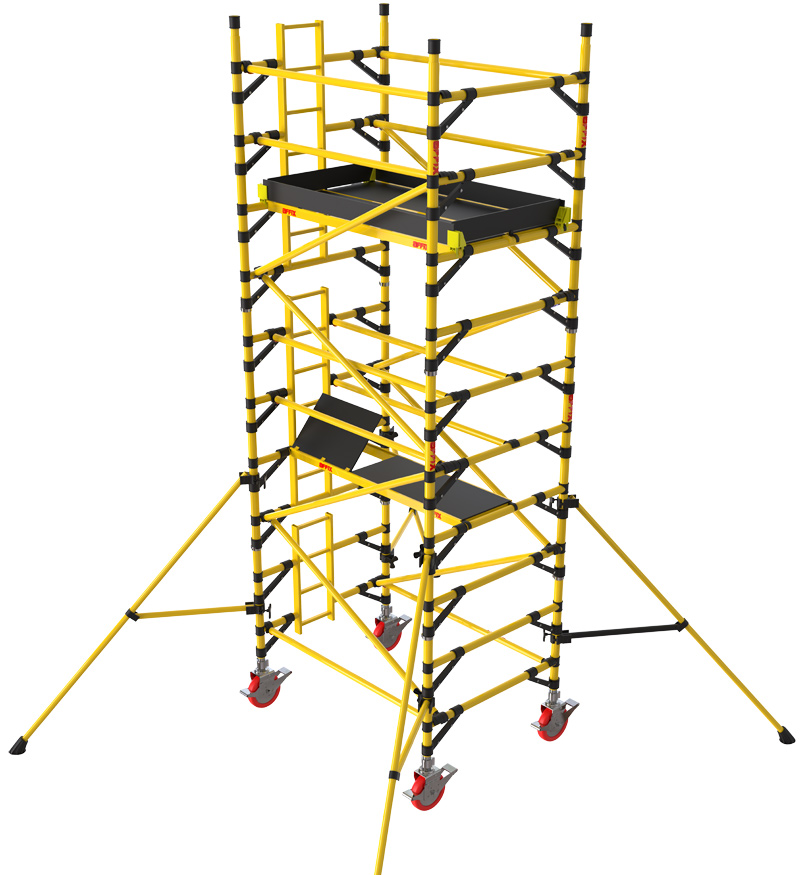When it comes to maintenance and repair works, especially in industries like construction, infrastructure, and utilities, scaffolding is a crucial element in ensuring safety and efficiency. Among various types of scaffolding available in the market today, Fiber-Reinforced Polymer (FRP) scaffolding has emerged as one of the most preferred choices. With its robust performance, durability, and safety features, FRP scaffolding is increasingly gaining traction in sectors requiring frequent maintenance and repair activities.

What is FRP Scaffolding?
Fiber-Reinforced Polymer (FRP) scaffolding is a type of scaffold made from a composite material that combines polymer resins with fiber reinforcements, usually glass or carbon fibers. This combination results in a lightweight, durable, and corrosion-resistant material that is ideal for use in harsh environments, including chemical plants, coastal areas, and other areas exposed to extreme conditions. FRP scaffolding is designed to replace traditional metal scaffolding and provides a host of benefits in terms of safety, performance, and longevity.
Advantages of FRP Scaffolding for Maintenance and Repair Works
- Lightweight and Easy to Handle: One of the primary reasons FRP scaffolding is favored for maintenance and repair tasks is its lightweight nature. Unlike traditional steel or aluminum scaffolding, FRP is considerably lighter, which makes it easier to transport, assemble, and disassemble. This is especially valuable for industries that need to carry out regular maintenance and repairs in various locations, as it reduces the labor time and costs associated with setting up scaffolding.
- Corrosion Resistance: FRP scaffolding is highly resistant to corrosion, making it the ideal choice for use in environments where traditional scaffolding materials such as steel or aluminum would deteriorate quickly. Industries such as chemical processing, marine, and wastewater treatment plants, where scaffolding is exposed to aggressive chemicals, salts, and water, benefit greatly from FRP’s ability to withstand such corrosive agents. The longevity of FRP scaffolding makes it a more cost-effective solution in the long run.
- Superior Durability: FRP scaffolding is known for its exceptional durability, which is crucial for maintenance and repair works. The material can withstand extreme temperatures, both hot and cold, and can resist impact, vibration, and other forms of physical stress. This makes it highly suitable for long-term use, ensuring that scaffolding remains stable and secure, even during prolonged maintenance projects.
- Non-Conductive Properties: Safety is paramount when performing maintenance and repair tasks, particularly in industries dealing with electricity and electrical equipment. FRP scaffolding is non-conductive, meaning it does not conduct electricity. This property makes it an ideal choice for use around electrical installations or high-voltage areas, reducing the risk of electrical accidents and ensuring worker safety.
- Versatility in Application: FRP scaffolding is incredibly versatile and can be used in various industries and applications. Whether it’s for maintenance work on tall buildings, offshore platforms, industrial plants, or bridges, FRP scaffolding can be customized to suit the specific needs of the project. The scaffolding system can be easily adapted to various shapes, sizes, and configurations, making it an ideal solution for a wide range of maintenance and repair tasks.
- Minimal Maintenance Requirements: Traditional metal scaffolding often requires regular maintenance to keep it in working order, such as painting to prevent rusting or checking for structural integrity. FRP scaffolding, on the other hand, requires minimal upkeep. Its corrosion-resistant properties eliminate the need for painting or anti-corrosion treatments, reducing both time and costs associated with maintenance.
- Cost-Effectiveness: Although the initial cost of FRP scaffolding may be higher compared to traditional materials like steel or aluminum, the long-term cost savings are significant. Due to its durability, corrosion resistance, and minimal maintenance needs, FRP scaffolding proves to be more cost-effective over time. It reduces the frequency of replacements and maintenance, making it a more economical choice in the long run.
- Improved Worker Safety: FRP scaffolding enhances worker safety in several ways. In addition to being non-conductive, the material is also slip-resistant, providing a stable platform for workers to carry out tasks. Furthermore, FRP scaffolding is designed with anti-slip features and ensures that workers have a secure and reliable working environment, reducing the likelihood of accidents due to slip and fall incidents.
- Environmental Benefits: FRP scaffolding is an eco-friendly option compared to traditional scaffolding materials. The production of FRP involves less energy compared to the production of metals like steel, which require high-temperature processes. Additionally, FRP scaffolding is often recyclable, making it a more sustainable choice for businesses aiming to reduce their environmental footprint.
Key Applications of FRP Scaffolding in Maintenance and Repair Works
FRP scaffolding’s benefits make it suitable for a wide range of industries and applications, especially those that require ongoing maintenance and repairs. Some of the primary sectors where FRP scaffolding is used include:
- Chemical Plants: In chemical plants, scaffolding is frequently used to access high and hazardous areas for maintenance, inspection, and repairs. Due to the corrosive nature of chemicals, traditional metal scaffolding can deteriorate quickly. FRP scaffolding, however, resists corrosion from chemicals and offers a safer, longer-lasting solution.
- Oil and Gas Industry: Oil and gas platforms, particularly offshore rigs, require scaffolding that can withstand harsh environmental conditions, including saltwater, high winds, and extreme temperatures. FRP scaffolding’s resistance to corrosion, light weight, and strength make it a preferred choice for oil and gas industry maintenance.
- Water Treatment Plants: Water treatment plants, where scaffolding is used for maintenance on pipes, tanks, and other structures, benefit from FRP scaffolding due to its resistance to corrosion caused by water, chemicals, and constant moisture exposure.
- Marine and Coastal Infrastructure: Due to its resistance to saltwater and humidity, FRP scaffolding is ideal for use in marine and coastal areas where traditional scaffolding materials would corrode rapidly. It’s frequently used in the maintenance of bridges, piers, and other coastal structures.
- Construction Projects: In the construction industry, FRP scaffolding is gaining popularity due to its lightweight nature and ease of use. It is particularly beneficial for maintenance work on tall buildings, historical structures, and complex architecture.
The Future of FRP Scaffolding
As industries continue to demand more sustainable, efficient, and safe solutions, FRP scaffolding is poised to play a significant role in the future of maintenance and repair work. Its lightweight, durable, and corrosion-resistant properties make it an ideal choice for businesses seeking to improve safety while reducing costs. Additionally, as technological advancements lead to even more efficient production methods, the cost of FRP scaffolding is likely to decrease, making it even more accessible to a wider range of industries.
Conclusion
In conclusion, FRP scaffolding is rapidly becoming the go-to solution for maintenance and repair works across various industries. Its combination of lightweight construction, corrosion resistance, durability, safety, and cost-effectiveness makes it an ideal choice for tasks that require both efficiency and long-term performance. Whether in chemical plants, offshore platforms, water treatment facilities, or construction projects, FRP scaffolding provides numerous benefits that traditional materials cannot match. As industries evolve and prioritize worker safety and environmental sustainability, FRP scaffolding is set to become an integral part of maintenance and repair work in the years to come.
FAQs About FRP Scaffolding
What is FRP scaffolding made of?
FRP scaffolding is made of fiber-reinforced polymer, which combines polymer resins with glass or carbon fibers, providing strength, durability, and corrosion resistance.
What industries use FRP scaffolding?
Industries such as construction, chemical plants, oil and gas, water treatment, and marine infrastructure use FRP scaffolding for maintenance and repair tasks.
Is FRP scaffolding more expensive than traditional scaffolding?
While the initial cost of FRP scaffolding may be higher, it proves to be more cost-effective in the long term due to its durability and low maintenance requirements.
How does FRP scaffolding compare to steel scaffolding?
FRP scaffolding is lighter, corrosion-resistant, and requires less maintenance than steel scaffolding, making it a more durable and long-lasting choice.
Can FRP scaffolding be used in offshore environments?
Yes, FRP scaffolding is ideal for use in offshore environments due to its resistance to saltwater and extreme weather conditions.
Is FRP scaffolding non-conductive?
Yes, FRP scaffolding is non-conductive, making it safe for use around electrical installations and reducing the risk of electrical accidents.
How long does FRP scaffolding last?
FRP scaffolding is highly durable and can last for many years with minimal maintenance, making it a long-term solution for maintenance and repair projects.
Is FRP scaffolding easy to assemble and disassemble?
Yes, FRP scaffolding is lightweight and easy to assemble and disassemble, which reduces labor time and makes it efficient for temporary projects.
What makes FRP scaffolding a safe option?
FRP scaffolding is slip-resistant, non-conductive, and stable, which significantly reduces the risk of accidents and ensures worker safety.
Can FRP scaffolding be used for high-rise buildings?
Yes, FRP scaffolding is commonly used for maintenance and repair work on tall buildings due to its lightweight and versatile design.
Does FRP scaffolding require regular maintenance?
FRP scaffolding requires minimal maintenance due to its corrosion-resistant properties, which eliminates the need for painting or anti-corrosion treatments.
Can FRP scaffolding be customized for different projects?
Yes, FRP scaffolding can be customized to meet the specific needs of different projects, whether it’s for height, shape, or load-bearing capacity.
Is FRP scaffolding eco-friendly?
Yes, FRP scaffolding is more environmentally friendly than traditional scaffolding materials due to its energy-efficient production and recyclability.
What are the main benefits of FRP scaffolding?
The main benefits of FRP scaffolding include its lightweight nature, corrosion resistance, durability, non-conductivity, and improved worker safety.
How does FRP scaffolding enhance worker productivity?
FRP scaffolding improves worker productivity by being lightweight and easy to assemble, reducing setup time and allowing workers to focus on their tasks.
Can FRP scaffolding be used in hazardous environments?
Yes, FRP scaffolding is ideal for hazardous environments like chemical plants, as it resists corrosion from chemicals and harsh weather conditions.
What are the weight limitations of FRP scaffolding?
FRP scaffolding is designed to support heavy loads, but the exact weight limitations depend on the specific design and configuration of the scaffolding system.
Can FRP scaffolding be used outdoors?
Yes, FRP scaffolding is highly suitable for outdoor use due to its resistance to weathering, UV rays, and environmental elements.
How does FRP scaffolding reduce the risk of accidents?
FRP scaffolding reduces the risk of accidents through its slip-resistant surface, stability, and non-conductive properties, which enhance worker safety.
Is FRP scaffolding a good investment for long-term projects?
Yes, FRP scaffolding is a great investment for long-term projects due to its durability, low maintenance costs, and overall performance in challenging environments.


